Zach Plesac is a few days removed from his fifth start of the season. In those five starts, he hasn’t looked quite right. The walks are low, and the home runs aren’t especially out of whack. The strikeouts are gone, though, and they’ve been replaced with a lot of hard contact. Plesac didn’t just become mediocre overnight. It’s clear something is up.
Already, Plesac was walking a tightrope of sorts. On one hand, I would describe his slider in 2020 as elite and his command as plus, and he throws his changeup for strikes better than most. At least in 2020. On the other hand, he has a fastball that gets put into play often — and when it does, it gets hit hard. I bought into the new-look Plesac in 2020, and I think it’s reasonable that he can get back to who he was last year without more than a tweak or two.
After giving it a cursory look a week or so ago, I came to the conclusion that Plesac had lost his slider. I think there’s more to it now, but I think it plays a part in Plesac’s current struggles. One reason that Plesac’s slider is such a good pitch is that he would throw it with a fair amount of gyro spin last year. It would come out of his hand with a 12:30 spin direction and cross the plate with an 11:15 spin direction due to the forces of seam-shifted wake. Plesac is spinning his slider more efficiently this year — and thus throwing with less gyro spin — and so he’s lost some of the spin direction differential between the time that he releases the ball and when it crosses the plate.
But it’s not only seam-shifted wake. Consider Plesac’s vertical and pitch movement, between 2020 and 2021:
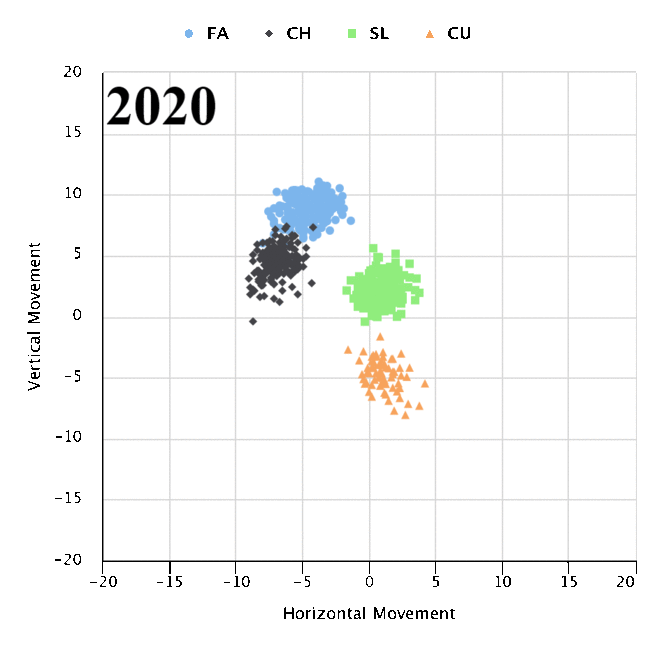
You can see that, especially compared to 2020, Plesac’s fastball and slider have begun to converge in movement. Before, Plesac had a velocity differential of about six miles per hour between his fastball and slider, with 16 inches of vertical separation (with gravity) and the effects of seam-shifted wake. Now? Their velocity differential has dropped to about five miles per hour, with only 12 inches of vertical separation (again, with gravity), and less profound effects of seam-shifted wake.
Given that the job of Plesac’s slider is to keep hitters off of his fastball, it’s not a good thing that they’re started to drift towards one another. His slider has still been a strong pitch, but its chase percentage has dropped by over 10 points, and its swinging-strike percentage has dropped by about eight points. Despite maintaining its spin and velocity, Plesac’s fastball has been decimated to this point, rendering a .517 xwOBA on the year thus far.
Now, in trying to pinpoint Plesac’s struggles, I was on his slider’s scent the whole way. That was a pretty intuitive thing to me. It was still peculiar to me, though, that Plesac has had so many struggles with his fastball. And what was even more surprising was that righties were starting to get the best of him. It could be the league finally adjusting to him, but I think a stronger interpretation is that Plesac himself had made an adjustment that wasn’t a good one.
Plesac’s horizontal release point by pitch, by month:

Perhaps the trend isn’t obvious. After all, the dot representing Plesac’s 2021 is just a teeny tiny dot at the top right of this figure. In any case, perhaps one of several changes that were fruitful for Plesac in 2020 was that he shifted his position on the rubber. Again, it’s not the only change — he shortened his arm circle even further and increased his pitch extension too — but his shift in May of 2020 coincides with a significant improvement in performance.
Plesac’s overall xwOBA, by month:

If I blindfolded you and told you to tell me which of these images was Plesac by xwOBA and which was Plesac’s horizontal release point (without the y-axis, of course), you’d probably ask me to un-blindfold you, because that’s really weird and creepy. After that, though, you might be hard-pressed to tell which is which. That’s how well the two factors correspond with one another.
What’s interesting is that Plesac has done just fine throwing strikes with his fastball against lefties. His struggles have come against righties, where has xwOBA has risen from .264 last year to .344 this year. His slider hasn’t been a detriment to him at all against righties. It’s his fastball, which (sample size beware!) has posted a meager 25.5% CSW against righties this year with a staggering 1.018 xwOBA. Again, the sample size is minute, but seven of Plesac’s batted fastballs against righties have turned into home runs. That’s not good.
And so, my hypothesis was that righties are seeing the ball much better coming out of Plesac’s hand with his current position on the mound. Well, consider the following gif:

I don’t know about you, but it doesn’t look like Plesac has shifted on the rubber. At all. This isn’t an isolated incident, either. In scouring the video, Plesac has stayed on the first base side of the rubber. What’s changed are his mechanics. I just wrote that Garrett Whitlock has some funk. Maybe Plesac has lost some of his.
Last year, one of the things that stood out to me about Plesac was his mechanics. After watching him this year, I’ve noticed that his leg kick has changed:
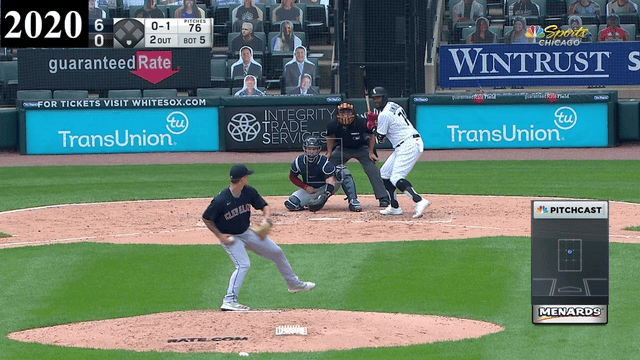
Adam Ottavino is unique, in that his delivery starts off in pretty standard fashion, and then he stretches out to the third-base side. Plesac is sort of the opposite. He had historically kicked his leg out towards third base before stepping towards the plate. Now that outward leg kick has much less drastic, and Plesac is much more direct to the plate. I’ll admit, these screenshots weren’t taken at identical moments in his delivery, but it’s changed enough where it was a little more difficult to do than normal.
At foot strike, things look pretty similar:
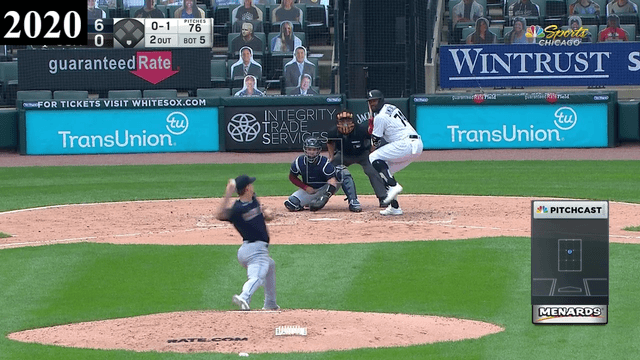
Release:
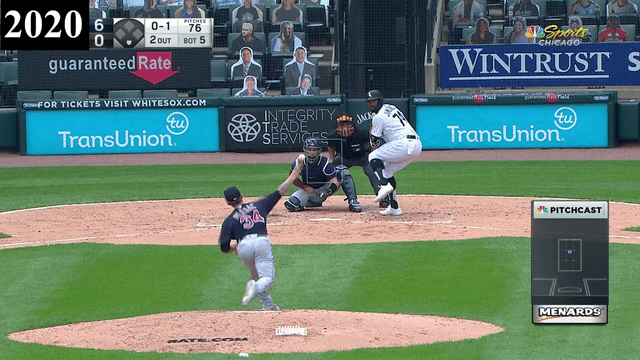
The camera angles aren’t identical, but it sure seems that, despite starting on similar positions on the rubber, Plesac gets to his release in a different way, and also releases at a different point in space. Don’t believe me? Check my work:
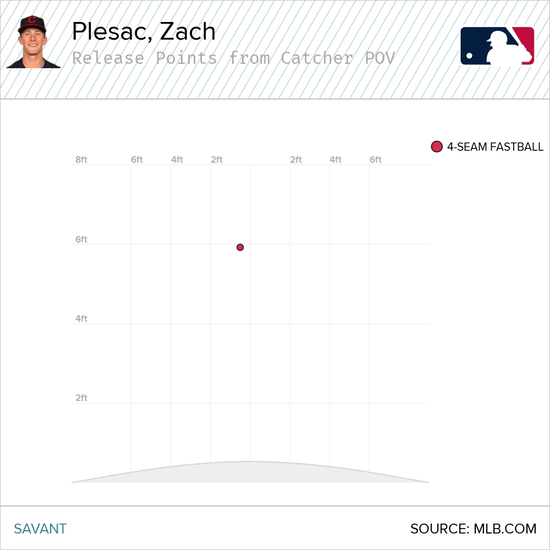
I have a feeling that Plesac has lost some deception. Not only via some loss in seam-shifted wake — which it itself is a form of deception — but also in his delivery. It’s hard to tell with the difference in camera angles, but part of me wonders if Plesac is postured in a way that’s more difficult for him to command his fastball. I pushed back on this notion, but perhaps it’s something to be considered.
There was a stretch of games where Plesac was looking like an ace. He may not have the fastball velocity, but he has the command, and we know he’s had the slider before. In-season adjustments aren’t necessarily easy, per se, but if I’ve identified some potential adjustments that Plesac may need to make, I’m sure he and Cleveland have identified some as well. And hey, maybe we’ve come to the same conclusion.
Photo by Ian D’Andrea (https://www.flickr.com/people/idsportsphoto/) | Adapted by Justin Paradis (@JustParaDesigns on Twitter)

